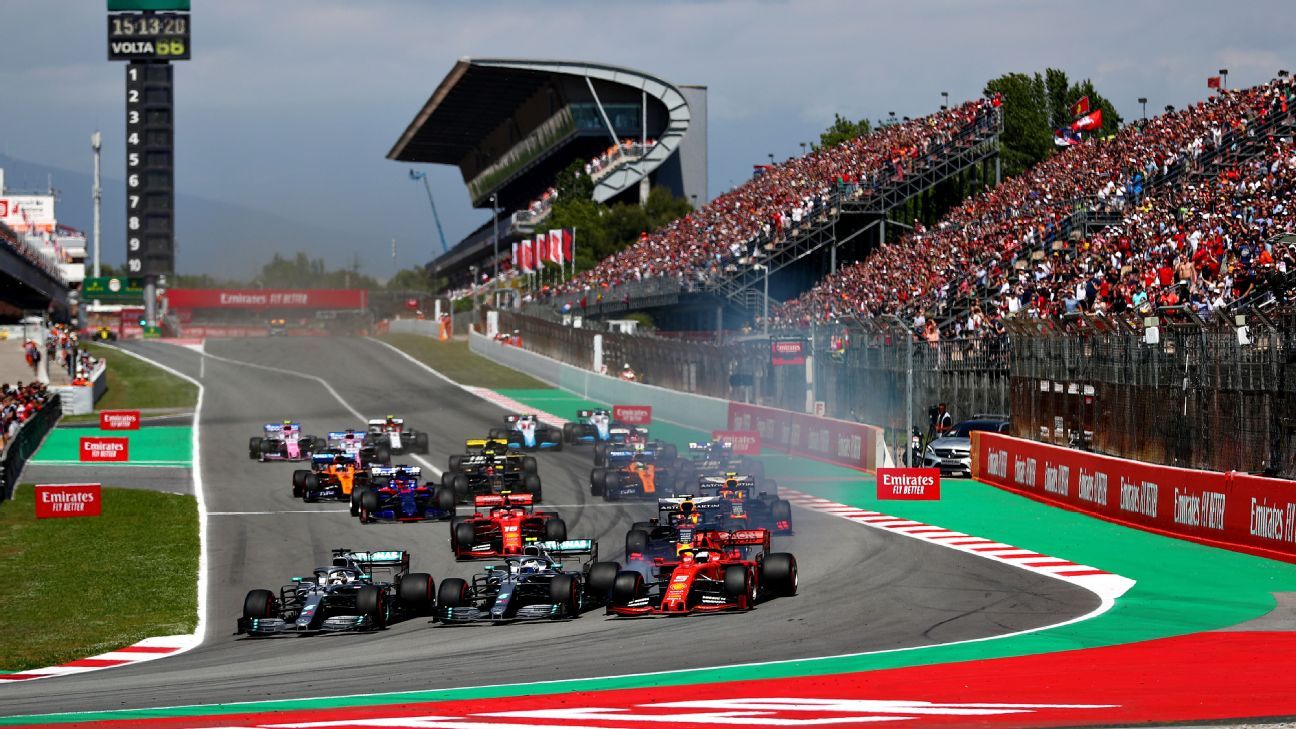The Australian Grand Prix on March 15 marks the start of the 2020 Formula One season. While its a slightly odd limbo year ahead of a sweeping rule change planned for 2021 which F1 hopes resets the pecking order, there is still plenty riding on what happens over the course of this season.
Here we look at the biggest factor lingering over each team going into the new year.
PRESEASON RECAP
Ranking the F1 grid after preseason
Is the 2020 Racing Point just a pink Mercedes?
What is Mercedes’ DAS system and is it a 2020 gamechanger?
Mercedes
Fixing its reliability problems
Does another Formula One season mean another Mercedes title? After preseason testing, you’d be brave to bet against it. But there is a sign of weakness in the Mercedes armoury and it lies right at the centre of the car.
The pace of the W11 was not in doubt during testing, but the reliability of the engine was. The car experienced three show-stopping failures — two to do with the ERS and one due to a loss of oil pressure. Any one of those would spell ‘DNF’ in a race and would likely result in a grid penalty later in the season. Further proof of the engine’s vulnerability came from the Williams camp after it suffered a series of Mercedes power unit failures over the two weeks.
One of the main weaknesses of last year’s engine was its fragility at higher operating temperatures, and that has been the main focus for Mercedes’ engine department in Brixworth over the winter. However, Mercedes also tasked Brixworth with making the power unit lighter and more powerful, and it may be that it has pushed beyond the limit with some parts of the design.
Mercedes believes it has found the source of each problem, but will have been against the clock to ensure all six race engines it supplies to its three teams (Mercedes, Williams and Racing Point) are reliable in time for the season-opener in Melbourne.
Ferrari
The simmering engine row
The season hasn’t even started and Ferrari already appears to be on the ropes. Both on track and off track the Italian team is struggling, with fresh accusations it was breaking the rules last year and a quite obvious lack of performance on track during testing. Both problems centre around the power unit and there’s a chance they are more closely related than Ferrari would like to admit.
The suspicion that lingered over the legality of Ferrari’s engine throughout 2019 returned to the headlines on the final day of testing this year when the FIA issued an oblique statement saying it had reached a settlement with the Italian team. The lack of information in the statement led to all of F1’s teams not powered by a Ferrari engine uniting against the FIA and demanding more transparency over the situation.
The governing body issued a clarification to explain why it arrived at the agreement with Ferrari, while admitting it had suspicions over the legality of the engine. The idea was that the settlement would ensure Ferrari was unable to continue exploiting an apparent grey area in the regulations, but while that appears to have been successful there are still big questions hanging over last year’s results .
Meanwhile, Ferrari appeared off the pace in testing and seemed to have lost all of its straight-line speed advantage it held over its rivals last year. While team boss Mattia Binotto insists that is down to a mix of reliability work on the engine and added downforce on the car, it doesn’t take an engineer to make the link between Ferrari’s problems off track and its lack of performance on track.
Add to that the expectation that follows Ferrari at every corner at this time of the year, and the famous Italian team is under a huge amount of pressure to perform in Australia.
Red Bull
Convincing Honda to stay
After a promising first season with new engine supplier Honda, Red Bull is looking to make another step this year and challenge for the title. That’s a lot to ask for, but it may be essential for Red Bull’s long-term future as Honda is only currently signed up until 2021.
The Japanese car giant has always seen its participation in F1 as an R&D project, but with the motor industry moving towards electrification there are genuine question marks over how much longer F1 will be relevant to the road. By only signing up until 2021, Honda is clearly keeping its options open and the success of Red Bull over the next two years could make or break its longer-term commitment to F1.
If Red Bull lost Honda, it would be back to square one – begging Ferrari and Mercedes for power units, but likely heading back to its difficult relationship with Renault. Success this year is arguably more important than ever for Red Bull.
McLaren
Gearing up for 2021
2020 is a crucial transitional year for all teams as they prepare for the 2021 regulations, but arguably it is even more important for McLaren. It is highly unlikely the British team will improve on its fourth place finish in the constructors’ championship last year and, even if it does, any gains in performance will be thrown in trash when the regulations change wholesale over the winter.
But McLaren is spinning a number of plates this year as it is also waiting for a new engine partnership with Mercedes to start in 2021 and a new wind tunnel to be completed. As a result, it must try to maintain momentum in 2020 and retain fourth place, while knowing the real focus is on next year and beyond.
In team boss Andreas Seidl, McLaren seems to have found the right man to lead it into the new era of F1 racing. The German has refrained from setting the kind of lofty targets which came back to haunt them in the 2010s and seems to understand what is needed to get the team back on top – and just how long that might take.
Renault
Managing pressure from above
As things stand, Renault is committed to F1 beyond the end of this year. That was a decision taken by interim CEO Clotilde Delbos during a company-wide review over the winter … the only problem is that she is due to make way for new CEO Luca de Meo in July.
There are no signs that de Meo, the former head of SEAT, is anti-F1, but if he wants a fresh start – and in doing so wants to cut some of the initiatives started under former CEO Carlos Ghosn – then pulling the plug on Enstone could be on the table. As is the case with Honda, there are real questions about how F1’s commitment to hybrid powertrains fits with the trend of government legislation that plans to outlaw petrol-driven cars in the next couple decades. As an early adopter of electrification, Renault is at the forefront of that change and there are serious questions over whether F1 still ticks the right marketing boxes.
Finishing fourth this year will undoubtedly help the F1 team prove its worth to the French manufacturer, but the promise of closing in on the big three needs to be realised sooner rather than later if it is to stay long-term.
Racing Point
Living up to its own expectations
The 2020 Racing Point car – which looks remarkably similar to the Mercedes which claimed the 2019 championship – was one of the major talking points of the preseason.
The car was launched with some lofty amibtions. Racing Point wants to be ‘best of the rest’ – otherwise known as fourth in the championship – but has also targeted multiple podiums before the year’s end. Toro Rosso managed that last year but both came in unexpected circumstances. Racing Point feels its new car will be close enough to the top three to be a threat on certain weekends – that’s a brave mindset in modern F1, which has effectively seen the top three racing in their own championship out in front.
The problem with big targets like that is the prospect of failing to deliver. The team formerly known as Force India has always excelled in overachieving on a limited budget but is now backed by Canadian billionaire Lawrence Stroll – his recent acquisition of Aston Martin stocks means the team will take on that name next year.
There’s clearly an exciting future on the horizon for the Silverstone-based team but it remains to be seen whether a big injection of cash automatically leads to results on the race track.
Alpha Tauri
Breaking out of Red Bull’s shadow
Toro Rosso’s rebrand to Red Bull’s clothing company, Alpha Tauri, comes with a significant shift in expectations. The team has traditionally operated as Red Bull’s junior team, where the company sends its future stars to make their F1 debuts, but the company wants to promote the fashion label on equal footing.
“There has been a change and an upgrade from a junior team to a sister team,” racing advisor Helmut Marko told Motorsport-Magazin at the Alpha Tauri launch. “Everything that is permitted and as far as our capacities are sufficient is provided to AlphaTauri.”
He added: “There will of course be a time lag. Because with the pace of development that Red Bull Racing has, we are more than challenged ourselves, especially in this early phase of the season.
“The delay will be between three and six months. An evolution that takes place at Red Bull can only be incorporated [at Alpha Tauri] by the middle of the season at the earliest, if at all.”
It’s easy to poke holes in Marko’s claim about how the team is now viewed — Alpha Tauri has two drivers to have been axed by Red Bull, Daniil Kvyat and Pierre Gasly. Both drivers managed to score a podium for the team last year, but the Faenza squad has never been a front-running team in its tenure on the grid. Preseason did little to suggest a major leap up the order is coming this year, although that is a lot to expect of any team.
Like everyone, Alpha Tauri will have shifted a lot of attention over to 2021 but how it performs this year might give some clues about how capable it is of living up to Marko’s new billing.
Alfa Romeo
Finding a way to stop the rut
The F1 team based in Hinwil, Switzerland has been fairly unremarkable in the recent past. In the V6 turbo era, the team known as Sauber finished 10th, 8th, 10th, 10th, 8th, and then, in its first year as Alfa Romeo, 8th again last year. There is no reason to expect that streak to end in 2020.
Alfa was arguably the most disappointing team during the six days of testing. Preseason suggested Alfa has produced another sluggish and unpredictable car for Kimi Raikkonen and Antonio Giovinazzi to drive and its main fight looks likely to be with Williams at the wrong end of the timing screens.
There is reason to be optimistic about the team’s future. It has recently commissioned its new state-of-the-art simulator at Hinwil, although it will not be ready for use until late 2021 at the earliest. With teams unlikely to spend too much time or resource upgrading these cars beyond the Spanish Grand Prix in May, Alfa’s prospects for the season look pretty bleak.
Haas
Convincing Gene F1 is worth the investment
Haas’ chastening 2019 season was hard for anyone at the team to stomach — especially team boss Gene Haas, whose NASCAR team has claimed 55 victories and two series championships in the Cup series. Speaking ahead of the current season it sounded as though Haas is already wondering whether his F1 project he wants to continue beyond 2020.
“I’m just kind of waiting to see how this season starts off,” he told Autosport about his long-term F1 plans. “But if we have another bad year, then it would not be that favourable.”
That’s a clear message to his team about the importance of the opening races this year, although it is unclear exactly what measuring stick Haas is using to judge its success. Haas has frequently voiced his frustration at F1’s imbalanced pecking order and how it is effectively locked into the midfield fight. The American team did a great job to finish fifth in 2018 but fell back to ninth last season as it struggled to understand the behaviour of its erratic race car.
In theory, the sweeping regulation changes set for 2021 present an opportunity for all 10 teams to become a front-running. While Haas is a racer at heart he is also a businessman and he would be foolish not to consider the ramifications of continuing to compete for scraps.
“We did five years. That was really the test – [we said] we’re going to do this for five years, see how it goes and evaluate it and then we’ll decide whether to go forward. I’m not saying we won’t be back. It has to be evaluated. To do it for another five years, though, that would be a big commitment.”
In the same interview, he added: “There’s so much change going on in Formula One, you really have to ask yourself is it really going to be worth the expense to try to implement all these changes? I know everyone thinks the changes are good, but, boy, they’re expensive.”
Williams
Future-proofing itself
Williams has clearly learned from the harsh lessons of 2019. After missing the start of preseason on that occasion, the team made sure its 2020 car was the first out of the garage at the Circuit de Catalunya this time around. But it still faces a season propping up the order, with preseason clearly showing the team goes into the Australian Grand Prix as the slowest team.
It’s hard to get excited about its on-track prospects this season but much of its key moments will be taking place behind the scenes. Williams has secured vital long-term backing from title partner Rokit – vital for one of the grid’s great independent outfits – and, as has been a running theme in this list, will be hoping to use the 2021 shake-up to return to the front end of the grid. How it goes about achieving that will be fascinating to see.


